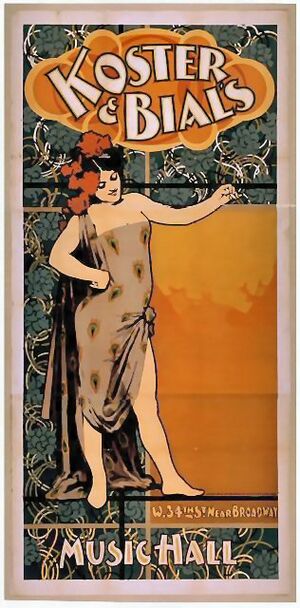- This page was last modified on 17 October 2025, at 10:18. Suggest an edit.
Koster & Bial's Music Hall facts for kids
 |
Koster and Bial's Music Hall was a very important vaudeville theater in New York City. It was located at Broadway and Thirty-Fourth Street. Today, the famous Macy's department store stands in its place.
This theater was quite large, holding up to 3,748 people. This was twice the size of many other theaters at the time. Tickets cost between 25 cents for a seat in the back and $1.50 for a seat closer to the stage. John Koster (1844-1895) and Albert Bial (1842-1897) started the venue in the late 1800s. It closed its doors in 1901.
Contents
The History of Koster and Bial's
This music hall was famous for showing many of the best performers of its time. It is also well-known in movie history. This is because it was the place where the Vitascope was first shown to the public. This special event happened on April 23, 1896.
Albert Bial was in charge of booking the acts. He brought in many great variety and foreign music-hall performers. Some famous names included Yvette Guilbert, Eugénie Fougère, Anna Held, Lottie Collins, Marie Lloyd, and Albert Chevalier. All these stars made their first American appearances at Koster and Bial's.
From Concert Hall to Music Hall
Koster and Bial's Music Hall was not the first theater owned by Koster and Bial. Before this, they had Koster and Bial's Concert Hall on 23rd Street. They took over Bryant's Opera House, which used to host minstrel shows. These were popular shows with music, comedy, and dancing.
At their concert hall, Koster and Bial offered both food and drinks along with the vaudeville acts. There was a law against serving alcohol in theaters. To get around this rule, they replaced the usual stage curtain with a folding fan. This small change allowed them to serve drinks.
Moving to a New Location
The final Koster and Bial's Music Hall opened when they moved to a new, bigger location. They took over the former Manhattan Opera House. This huge theater was built in Herald Square in 1892 by Oscar Hammerstein I. He built it because he loved grand opera.
However, Hammerstein quickly faced money problems. He decided to change his opera house into a vaudeville theater. He offered Koster and Bial a partnership. Hammerstein would manage the shows, and Koster and Bial would handle the food and drinks.
The new Koster and Bial's Music Hall opened on August 28, 1893. It became very successful. But Hammerstein and his partners had disagreements, which led to lawsuits. In the end, Koster and Bial bought out Hammerstein. They then ran the theater completely on their own. The theater finally closed in 1901. It was torn down to make way for Macy's Department Store.
The First Vitascope Show
A small advertisement appeared in The New York Times on April 19, 1896. It was mixed in with many other theater ads. It read:
- KOSTER AND BIAL'S MUSIC HALL, 34th st.
- TO-MORROW (MONDAY) NIGHT.
- THE ONLY CHEVALIER.
- 2---NEW SONGS---2
- Together with all the other
- GREAT FOREIGN STARS.
- EXTRA--Due notice will be given of the first
- public exhibition of Edison's latest marvel,
- THE VITASCOPE.
The Vitascope was actually invented by Thomas Armat. However, Thomas Edison's company bought and sold it. They presented it as if Edison himself had invented it. The Vitascope projected moving pictures onto a large screen. The screen was twenty feet wide and had a fancy gold frame.
On April 24, The New York Times reported on the event:
- EDISON'S VITASCOPE CHEERED. "Projecting Kinetoscope" Exhibited for First Time at Koster and Bial's. ... The clever inventor's newest toy shows his kinetoscope figures. They are projected like slides onto a white screen in a dark hall. In the middle of the balcony, there is a strange object. From below, it looks like a big ship's double turret. The front of each half has two long, narrow holes. The turret is neatly covered with blue velvet fabric. The moving figures appear about half life-size.
- ...a buzzing and roaring sound came from the turret. A very bright light then shone onto the screen. Two young blonde women from the stage appeared. They wore pink and blue dresses and did a fast umbrella dance. Their movements were very clear. After they disappeared, a view of angry waves crashing on a sandy beach near a stone pier amazed the audience. Other scenes included a funny boxing match, a comedy called "The Monroe Doctrine," a short moment from a play called "A Milk White Flag" repeated many times, and a skirt dance by a tall blonde woman. All the views seemed wonderfully real and exciting.
A later Times article mentioned another interesting plan. It said that Mr. Edison had bought two old but working train engines and many flat cars for about $5,000. He built about a quarter-mile of railroad track in a hidden spot near his lab. He planned to start trains from each end of the track and make them crash. Machines placed along the track would record all the details of the train wreck.
See also
- White Rats of America

